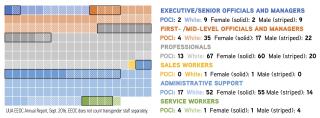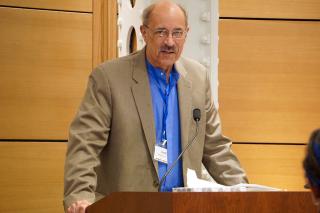Advertisement
Forty percent of people in managerial and decision-making positions on the Unitarian Universalist Association staff should be people of color and/or indigenous people, the three interim co-presidents of the UUA announced June 6, in releasing new interim hiring procedures.
No UUA employees will be terminated in order to meet these goals, they said. The policy will guide all new hires, with only the UUA president able to make exceptions—and “such exceptions should be exceedingly rare,” the procedures state.
Overall, the UUA staff should be 30 percent people of color/indigenous people, the new procedures state. But the explicit goal of the new policy is to increase the percentage of employees in managerial and professional roles who do not identify as white. “Recognizing that the culture of white supremacy is a culture of power, the goals for persons of color in decision-making roles is higher than the goal overall for the staff,” the co-presidents said. “We will therefore set the goals at 30 percent overall and 40 percent for managers (Executives, Managers, and Professionals).”
Meeting these standards requires tripling the racial and cultural diversity of the UUA’s managerial and professional staff. The UUA had 205 employees when it submitted its 2016 annual report to the Equal Employment Opportunity Commission (EEOC), 63 percent of whom held managerial or professional positions. First- and mid-level officials and managers are the least diverse cohort at the UUA, with only 10 percent people of color right now. The Southern Region lead position—which provoked controversy when it was given to a white male minister in March before he ultimately stepped aside—falls in this category.

Just under 20 percent of the UUA’s 205 employees—and just under 15 percent of the 130 employees in its top three employment categories—identified as people of color, according to the UUA’s 2016 report to the U.S. Equal Employment Opportunities Commission. The UUA interim co-presidents have set a staff diversity goal of 30 percent for the staff overall, and 40 percent for the top three categories of employees.
This chart presents the 2016 EEOC data, with the number of people of color shown first in each category and with female employees shown first within each POC and white subgroup. The EEOC does not count transgender employees separately. (© Christopher L. Walton)
If UUA leaders apply the new procedures to all employees hired to executive, managerial, and professional positions, and if the number of positions remains stable, the diversity goals will not be met until thirty-three positions held by white employees in 2016 are held by people of color/indigenous people. If the new procedures are applied only to executive and managerial positions, however, the 40-percent diversity goal would be met when fourteen positions currently held by white employees are held by people of color.
Interim Co-Presidents Sofía Betancourt, William G. Sinkford, and Leon Spencer have been working on new hiring policies since they were appointed April 10 to serve the remainder of the term of former UUA President Peter Morales, who resigned April 1 amid controversy over hiring practices that critics say favor white people, especially white ministers. The co-presidents immediately instituted a modified hiring freeze until new hiring policies could be developed.
Because no one will be terminated in order to reach the new diversity goals, and because staff turnover historically has been low, Sinkford said he did not know how long it will take to achieve them. However, he said, “the important thing is movement toward these goals” as an integral part of Unitarian Universalism’s commitment to ending white supremacy.
At a UUA staff meeting on June 8, Sinkford said that the co-presidents originally drafted a hiring policy that “looked much more like a quota system” and would have necessitated that all new hires be people of color/indigenous people until the association met its diversity goals. But that approach is illegal under federal anti-discrimination laws, he said, and so the co-presidents modified the procedures.
Currently, less than 20 percent of UUA staff are people of color/indigenous people. In Massachusetts, where the UUA is headquartered and where 62 percent of its employees work, the overall rate of employment of people of color in the “religious, grantmaking, civil, professional, and similar organization” sector is 23 percent, according to 2015 statistics from the EEOC.
Across all industries in Massachusetts, non-white employees make up 27 percent of the workforce. Nationwide, 38 percent of workers are people of color, according to the EEOC.
“Given our commitments as a faith community and our collective aspirations, a result that is ‘almost as good’ as the typical religious community is unacceptable,” the new procedures state.
The new procedures were adopted by the co-presidents after “considerable discussion” with staff, key volunteers, and institutional partners, as well as legal review, they said. They will remain in place until review by the Commission on Institutional Change, currently being led by Betancourt, which may choose to modify or replace them, the co-presidents said. Beacon Press, which has exceeded the stated goals in its staff hiring, is exempt from the procedures, they said.
The three candidates running for election as UUA president—the Rev. Susan Frederick-Gray, the Rev. Alison Miller, and the Rev. Jeanne Pupke—have been kept informed as the procedures have been developed and have indicated they will continue to implement them, Sinkford said. A new president will be elected June 24 by the General Assembly in New Orleans.
“Based on what I know about the commitment of the three candidates, I believe all three are committed to making forward movement on these issues,” Sinkford said.
The UUA president, chief operating officer, Leadership Council, and all hiring managers will be accountable for meeting the goals. Rob Molla, the UUA’s director of Human Resources, said there is some interpretative work to do to decide exactly which positions at the UUA fall into the 40-percent category, which he expects the new president and her administration to address.
“It’s going to take really significant energy and dedication by our hiring managers and staff group directors to make this happen,” said Molla, but added, “I think there are really exciting opportunities for us here, so I’m really looking forward to it.”
The co-presidents said the new hiring procedures “center on shifting the focus of our attention from intention to outcome, on establishing numerical goals which can form the basis of accountability for all hiring managers, and setting expectations that the experience of persons of color/indigenous persons is of important value for staff members in our religious community.”
In their statement, the co-presidents added, “The good news is that this approach and similar approaches have been successful for others and therefore can be successful for us.”
Sinkford told UU World he is “much encouraged” that other UU organizations, including Beacon Press and the UU Service Committee, “have been able to meet and exceed these goals using this kind of approach.” But “absolutely central” to success is that senior managers and hiring managers be committed to the goals. Since there will “always be requests for exceptions,” it is essential that they “need to be exceptionally rare.”
In what he humorously described as “the shortest interim in recorded history,” Sinkford said that he, Betancourt, and Spencer “have worked well together and in fact have loved working with one another. I think we have made some good progress and put in place some good plans, and it is my profound hope we have laid a firm foundation on which new leadership can move forward.”
With additional reporting by Christopher L. Walton.
